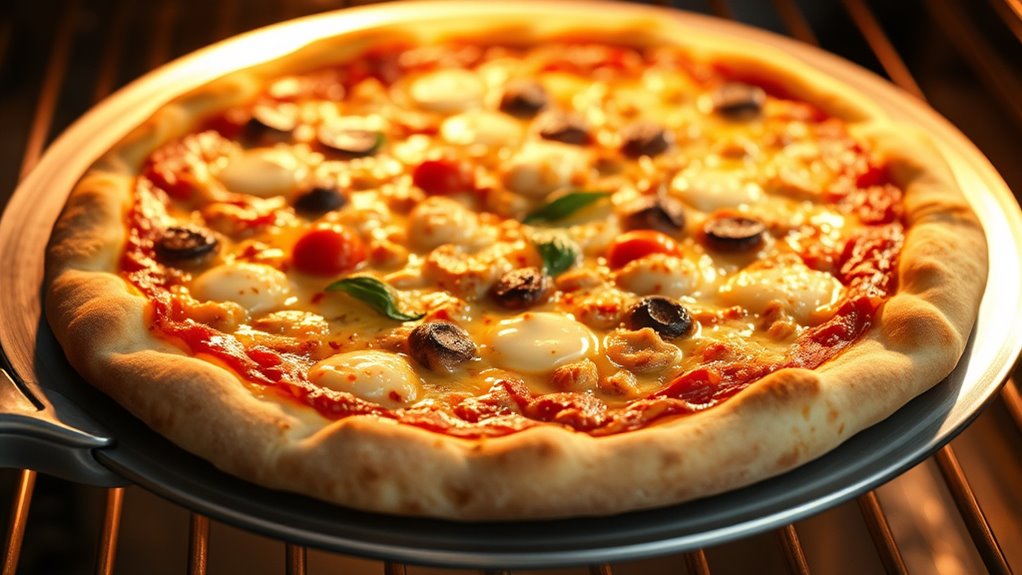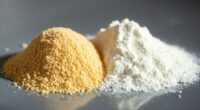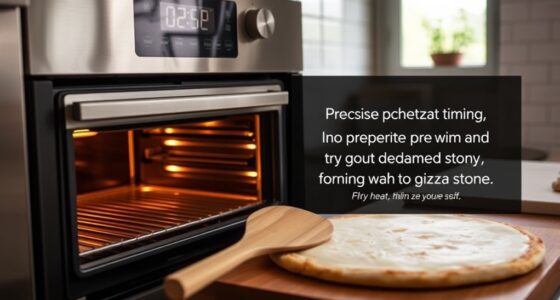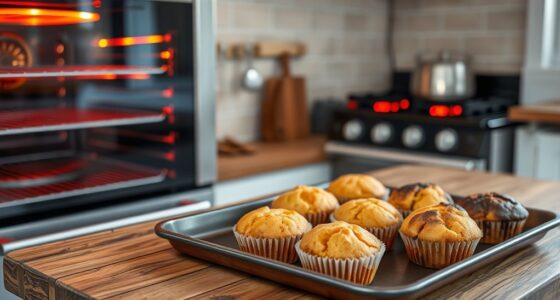To cook your pizza evenly, plan to rotate it every 4 to 6 minutes during baking. Whether you’re using an oven with uneven heat or a pizza stone, turning the pizza regularly helps prevent hot spots and promotes uniform crust and topping doneness. Use a pizza peel or spatula to do this gently and safely. Paying close attention to how your pizza looks and adjusting the rotation frequency can lead to perfect results—more tips await to help you master the process.
Key Takeaways
- Rotate the pizza approximately every 4–6 minutes during baking for even heat exposure.
- Turn the pizza 180 degrees each time to counteract oven hot spots.
- Use a pizza peel or spatula for gentle, safe rotations without disturbing toppings.
- Check crust browning and topping doneness regularly to determine if additional rotation is needed.
- Adjust rotation frequency based on oven performance and how quickly the pizza cooks.

Rotating pizzas have become a popular way to achieve evenly cooked crusts and toppings, guaranteeing every slice tastes just as delicious as the last. When it comes to baking pizza, mastering the right baking techniques is vital, and a key part of that is understanding how often to turn the pizza during baking. Proper rotation helps prevent hot spots and ensures consistent heat distribution, which is especially important if your oven doesn’t have a perfectly even heat source. By adjusting the oven temperature and rotating your pizza at the right intervals, you can get a perfectly cooked pie every time.
Most home ovens tend to have uneven heat distribution, which can cause certain areas of your pizza to cook faster than others. To counteract this, you should preheat your oven thoroughly—ideally to a high temperature, typically between 475°F and 500°F. A hot oven promotes a crispy crust and well-melted toppings, but it also increases the risk of burning if you’re not vigilant. That’s why rotation becomes essential. Once you place your pizza in the oven, keep a close eye on it, and after about 4 to 6 minutes, check its progress. If the crust is browning unevenly or the toppings are cooking faster on one side, it’s time to rotate.
Preheat your oven to 475–500°F and rotate the pizza every 4–6 minutes for even cooking.
You should turn the pizza 180 degrees to promote even baking. This is especially true if you notice one side is browning more quickly. Rotating your pizza at regular intervals, about every 4-6 minutes, helps ensure that each section of the crust and toppings receives equal exposure to the heat. Keep in mind that if your oven has hot spots or if you’re using a pizza stone or baking steel, rotation becomes even more important. These tools absorb and radiate heat differently, so turning the pizza helps prevent overcooking or burning in certain areas.
Furthermore, using a pizza peel or a heat-resistant spatula makes the process easier and safer. When you rotate, do so gently to avoid disturbing the toppings or creating uneven distribution. Remember, the goal is to maintain a consistent oven temperature and use rotation as a technique to compensate for any uneven heat. With practice, you’ll develop a sense of how often to turn your pizza and at what point it’s done. The key is to stay attentive and adapt your rotation timing based on your oven’s behavior and the specific pizza you’re making. This way, you’ll consistently produce pizzas with perfectly cooked crusts and toppings, every single time.
Frequently Asked Questions
What Tools Are Best for Rotating Pizzas?
You should use a pizza peel to rotate your pizza easily without burning your hands. It allows you to lift and turn the pizza smoothly, ensuring even cooking. Pair it with sturdy oven mitts to protect your hands when handling hot surfaces. For best results, use the peel to rotate the pizza every few minutes, especially near the end of cooking, to achieve a perfectly even, crispy crust.
Should I Rotate the Pizza During the Entire Bake?
Think of your pizza as a story unfolding in your oven. You should flip the pizza once or twice during baking to guarantee even crust management and a perfectly cooked top. A pizza flip helps prevent hot spots and promotes uniform heat distribution. Keep an eye on it, turn it when the crust starts to brown, and you’ll achieve a beautifully balanced, crispy crust and evenly melted toppings.
How Does Oven Type Affect Rotation Timing?
Your oven type critically affects rotation timing. If you have a conventional oven with uneven heat distribution, you should rotate your pizza more frequently, like every 2-3 minutes, to guarantee even cooking. In contrast, a convection oven with better temperature consistency requires less frequent rotation, maybe every 4-5 minutes. Ovens with uneven material or hot spots make timely rotation vital for a perfectly cooked pizza.
Can Uneven Toppings Influence How Often I Rotate?
Uneven toppings can definitely influence how often you should rotate your pizza. If toppings are unevenly distributed or your crust varies in thickness, it creates hotspots that cook faster or slower. By rotating more frequently, you guarantee the toppings stay perfectly cooked and the crust remains crispy. Keep an eye on these elements—topping distribution and crust thickness—and adjust your rotation timing to achieve that flawless, evenly cooked pizza you crave.
Is There a Difference in Rotation Frequency for Thin vs. Thick Crusts?
Yes, crust thickness influences rotation frequency because thin crusts cook faster and need more frequent turning to prevent burning, while thick crusts require less frequent rotation to ensure even heat distribution. You should turn thin crust pizzas every 2-3 minutes and thicker ones every 4-5 minutes. This approach helps achieve uniform cooking, preventing hot spots and ensuring the crust is evenly baked throughout.
Conclusion
Remember, turning your pizza is like guiding a ship through calm waters—you steer it to make certain it reaches its destination perfectly cooked. Just as a compass points true, your rotations keep the heat balanced, leading to that golden, crispy crust and bubbling cheese. So, every time you rotate, you’re not just flipping dough; you’re steering your culinary voyage. Trust the process, and soon you’ll be the captain of pizza perfection on your own kitchen seas.









